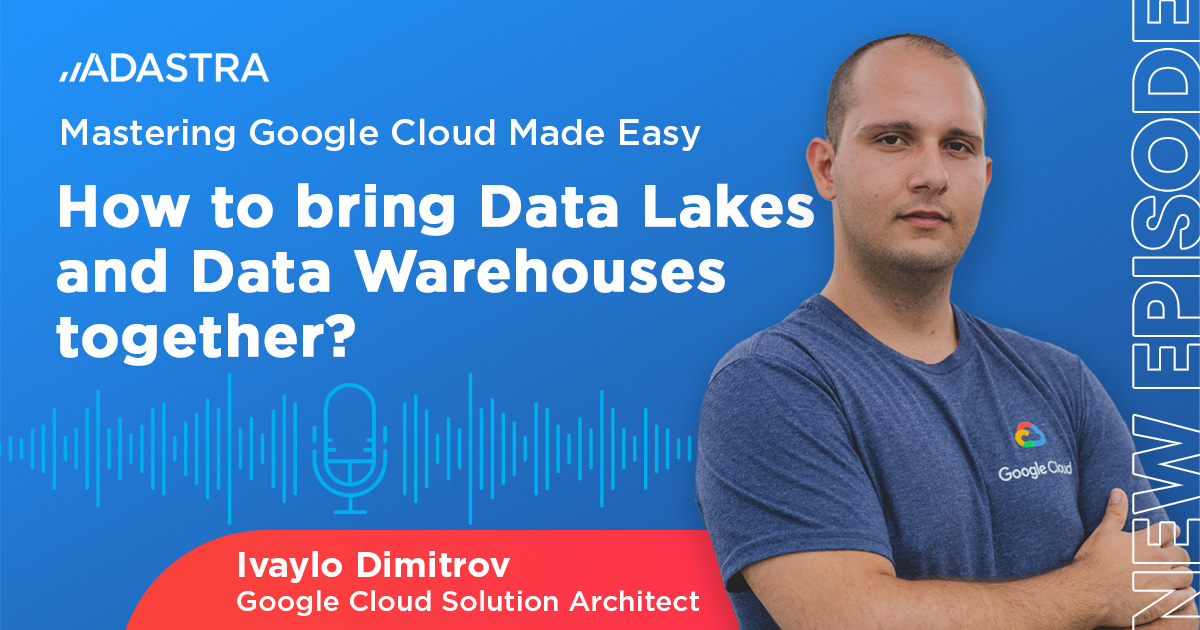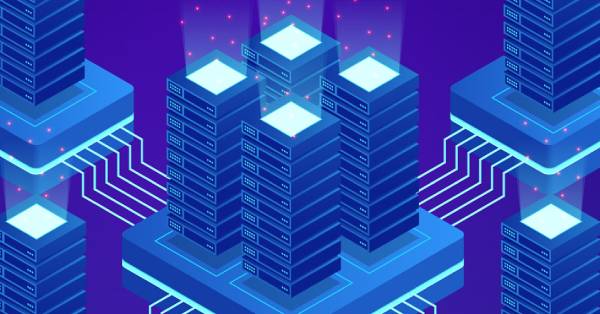Insights
How to Perform a Google Cloud Migration
January 6, 2021
One of the first steps to digital transformation in most cases is migrating workloads to the cloud because it makes the systems more reliable while often saving infrastructure costs. But which is the best way to perform a cloud migration?
Frankly, I do not have a single right answer. Relying to myself as a certified Google Cloud Architect, an effective integration of cloud environments is an essence to successful enterprise digital transformation. There are a couple of Google Cloud migration methodologies. Each one provides its own advantages depending on the specific business needs. In this article, I will describe the most common cloud migration strategies along with some of their advantages and use cases.
Digitalization of core business processes could do more than just making the company more competitive… instead, it should position you to excel by untethering IT staff from low value, labor-intensive tasks, allowing them to focus on innovation and high-impact projects.
“The cloud service companies of all sizes… The cloud is for everyone. The cloud is a democracy.”
Marc Benioff, Founder, CEO and Chairman of Salesforce
Cloud computing certainly democratizes access to cutting-edge technologies. By lowering the cost and prioritizing remote access to apps and data, users (and businesses) are gaining level footing with larger enterprise corporations. In other words, you do not have to have a million-dollar IT department to have a voice or a technological edge. Cloud computing is a better way to run your business. That makes you more secure and flexible than ever before.
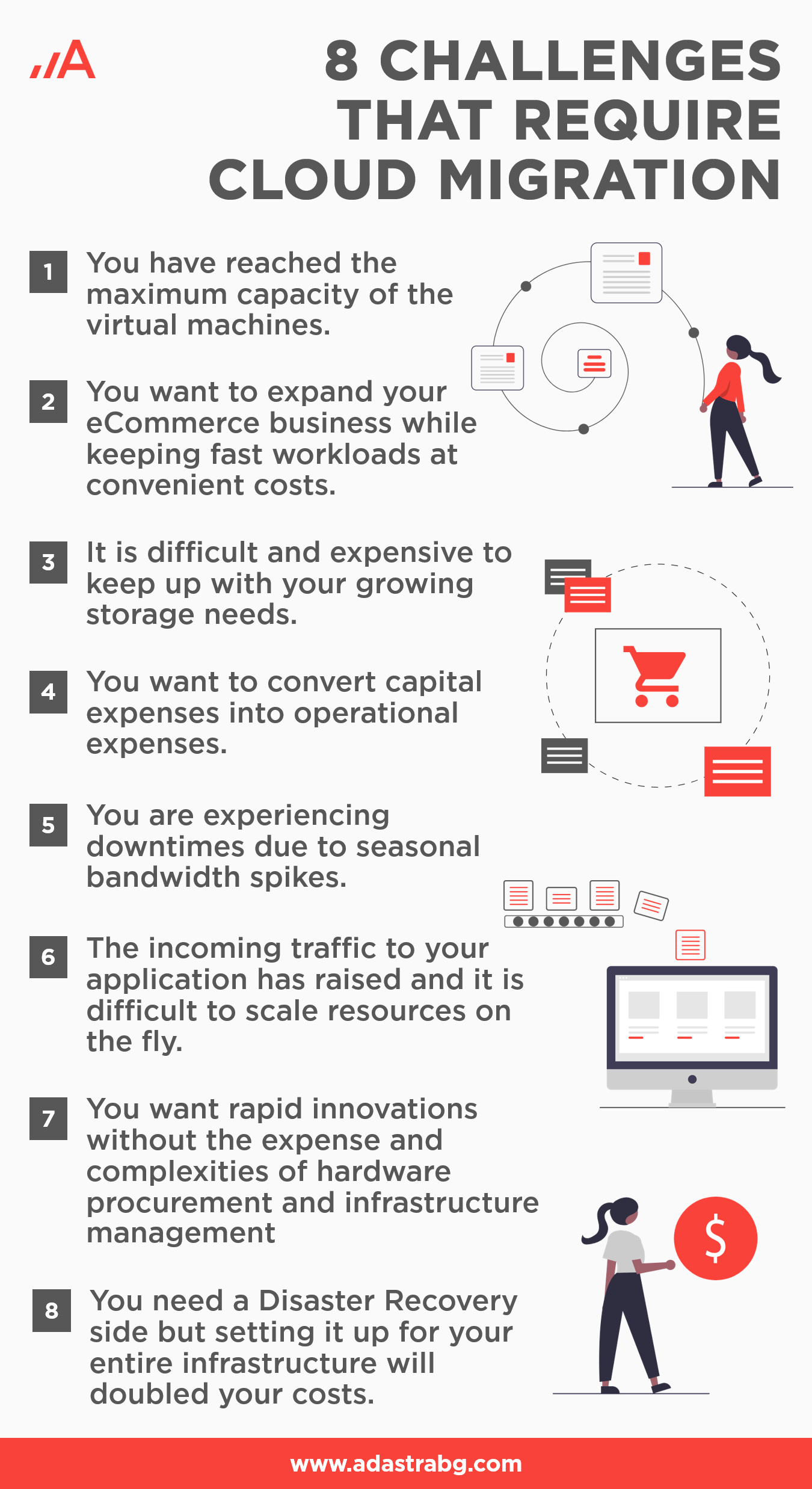
Illustration: 8 Challenges that Require Cloud Migration
Migrate Virtual Machines (VMs) to Google Compute Engine GCE (Velostrata)
In my experience, migrations to Google Cloud have never been so easier. Velostrata facilitates migration to Google Cloud from enterprise on-premise data centers. It allows the companies to migrate their infrastructure not in whole lump, but in stages (formally Migration Waves). I believe that Migration Waves are the key to more manageable and easier changeover.
Thinking over the better cloud migration approach, the main pointers are your business goals and internal capabilities, along with the technical aspects of your system infrastructure. Keep in mind that there is no one-size-fits-to-all cloud migration approach. Whatever path you choose, it may turn out that a custom cloud migration approach is the best option for you.
GCP Migration Approach: Lift and Shift Cloud Migration
The Lift and Shift approach gives you the opportunity to get an immediate infrastructure modernization, followed by additional adjustments and improvements. It enables you to shift your workloads as needed and decrease the stress upon your infrastructure.
I recommend this approach to be adopted by companies which are newbies in cloud technologies or in Google Cloud Platform. This approach provides you with a minimum risk while gradually ramping up your teams’ cloud knowledge. The cloud migration is executed without code changes or with minimum ones to the existing applications.
Cloud Migration Use Case
An online retail company is looking for a solution to handle bandwidth spikes due to upcoming increase in seasonal demand. Read the Lift and Shift cloud migration use case here.
Sounds familiar? Get in touch to learn more about solving this problem.
Advantages of Lift and Shift cloud migration
- If your time matters and you want to be ASAP in the Google Cloud.
- Minimal to no architecture changes will be required.
- Enjoy a seamless infrastructure migration process.
- During the lift and shift migration you can identify further potential of the more aggressive Google Cloud migration strategies.
GCP Migration Approach: Move and Improve
I recommend this approach if you are aiming to get more benefits from Google Cloud migration in the long run. I personally suggest you adopt this infrastructure modernization approach if you want to improve your application performance and launch new features.
While designing the Move and Improve cloud migration model, you can take advantage of cloud native capabilities and leverage cloud features such as scalability, reliability, resiliency, and high availability. You need to evaluate the extra mile in the life cycle of the migrated application. Keep in mind that it will require a bit more time to add new skillset to your team and it may be difficult to fit the timelines. You may need the support by experienced cloud migration provider by your side in this endeavor.
Cloud Migration Use Case
Current workload cannot fit the target environment and minor changes are required as well as modification and updates while migrating to the cloud. Including adding new features to existing core functionalities, improving performance of base components with introducing in your current architecture some of the cloud native capabilities.
Advantages of Move and Improve migration
- Improve your application`s features while migrating to the cloud.
- Leverage cloud native capabilities.
- Expand your current team`s skillset.
- Less time to land in the cloud than the RIP and Replace strategy.
RIP and Replace
Leverage the full benefits of Google Cloud migration with this refactoring approach. It will cost you a bit more time and it is the most aggressive one, due to decommissioning the existing applications and recreating them as serverless and Cloud Native. The RIP and Replace strategy offers elasticity, scalability, resiliency, and high availability, while saving you a bunch of money in the long run. This cloud migration approach ensures scalability and flexibility for much faster respond to market changes, however, it requires the largest amount of time and development skills.
Use case
Your existing applications do not fit Google Cloud Platform’s ecosystem due to legacy infrastructure.
Advantages of the RIP and Replace cloud migration approach
- Utilize full cloud native benefits – go native
- Get rid of technical debt accumulated over the years
- Google Cloud Migration Benefits (Infographic)
- Minimum downtime to no downtime of your production system.
- Start testing new environment as soon as migration process is fired up.
- Get an instant access to your data in the cloud that facilitates easy querying.
- Rollback the systems to the initial state as easy as the initial migration.
- Satisfy on-demand surge capacity.
Useful Tool: Google Cloud Pricing Calculator
Did you recognize yourself in one of these use cases? If the answer is “Yes”, you should be pleased to know that there is a Google Cloud Pricing Calculator. It helps you calculate how much your infrastructure and workloads will cost in Google Cloud.
If you experience any difficulties, you can reach out to us by submitting the contact form below. We will help you handle this for free.
Migrate to Google Kubernetes Engine (GKE) or Anthos (Migrate for Anthos)
What does Anthos mean? What do Kubernetes or GKE actually do? What is the relationship between Anthos and Kubernetes? Keep reading if you want to find out some of the answers.
Anthos is the latest innovation in hybrid and multi-cloud computing. It will enable you to modernize your applications with the latest known innovative technologies. For the past year Google Cloud are working hard on enabling their customers to be multi-cloud in terms of cloud infrastructure. As of December 2019, they already have built an alfa version of one premium data warehouse multi-cloud solution – BigQuery OMNI. Stay tuned for more information or reach out to us to get more details.
In the diagram below you can see the process of Migrate for Anthos. It is similar with Migrate VMs to GCP process. The same components and plug-ins are required. In addition to that, in Migrate for Anthos is important to mention that the process is started from the user. In order to understand the importance of that, you must be aware of how Kubernetes works. If you let me describe it in a nutshell, basically, you have a Kubernetes master node which holds the rules, and there are slaves which are executing them.
Curious to know more? Get in touch to find more details.
To set those rules on the master node, you need to introduce a deployment policy or in other words the YAML file, which includes all instructions on how to use this as a source and recreate it in the Google Cloud Platform. Initially, all data is residing on-prem and being cached in the Google Cloud. It enables you to start testing immediately. Meanwhile, on the background, as in the previous service – storage could continue migrate.
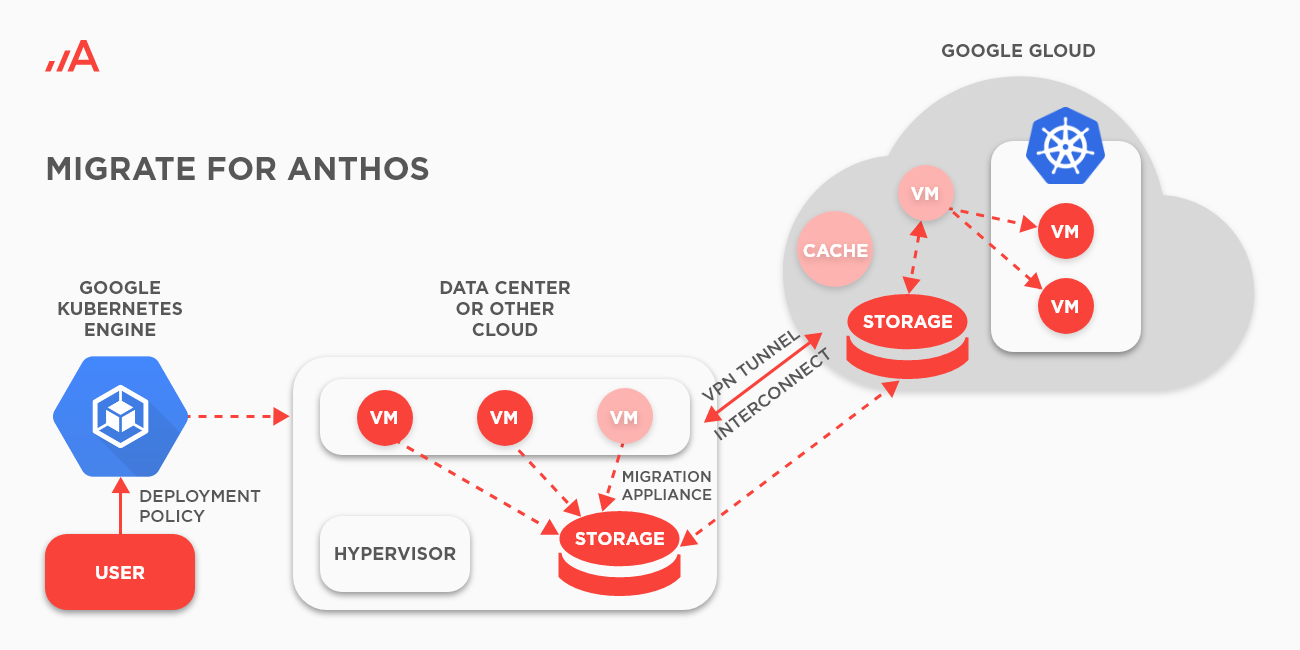
Figure 1: Migrate for Anthos
Use Case
Migrate to Anthos is for those who’ve tried GKE but for any reason can’t move entirely to the cloud. Or maybe they’re in another cloud, and they’re planning to move to GCP in the future. In any case, you can start with GKE On-Prem and then decide where to host your workloads later.
What can be migrated?
Web Applications, Application Servers, Business logic, Multi-VM, Multi-tier stacks, such as Tomcat, Websphere MQ, Weblogic, SAP Hybris, even Oracle, SQL Server… in either Linux or Windows container.
Advantages
- Take immediate benefits from containerization.
- Incorporate legacy applications with cloud native services.
- Leverage image-based container management and orchestration.
- Scale-up easily to multi-cloud architecture in the future.
Migrate your data without exposing to public network (Transfer Appliance)
All described above is about migrating current workloads to Google Cloud. But what about your data?
According to my experience, data is the most delicate part of every cloud migration. Let`s imagine we have a custom data warehouse integrated with a CRM on virtual machines that have been in use for the past 10 years. And now we want to migrate them to Google Cloud. Looks pretty straightforward, doesn’t it? … selecting the virtual machines and move them to the cloud (lift and shift).
BUT, there it comes the corner case – for the past 10 years our servers have grown up to 500TBs of data. It will take us about 18 months to upload all this data to the Google Cloud Platform thru the standard network. But some of you might ask “Why to use a standard network when we can use a Direct Interconnect”?
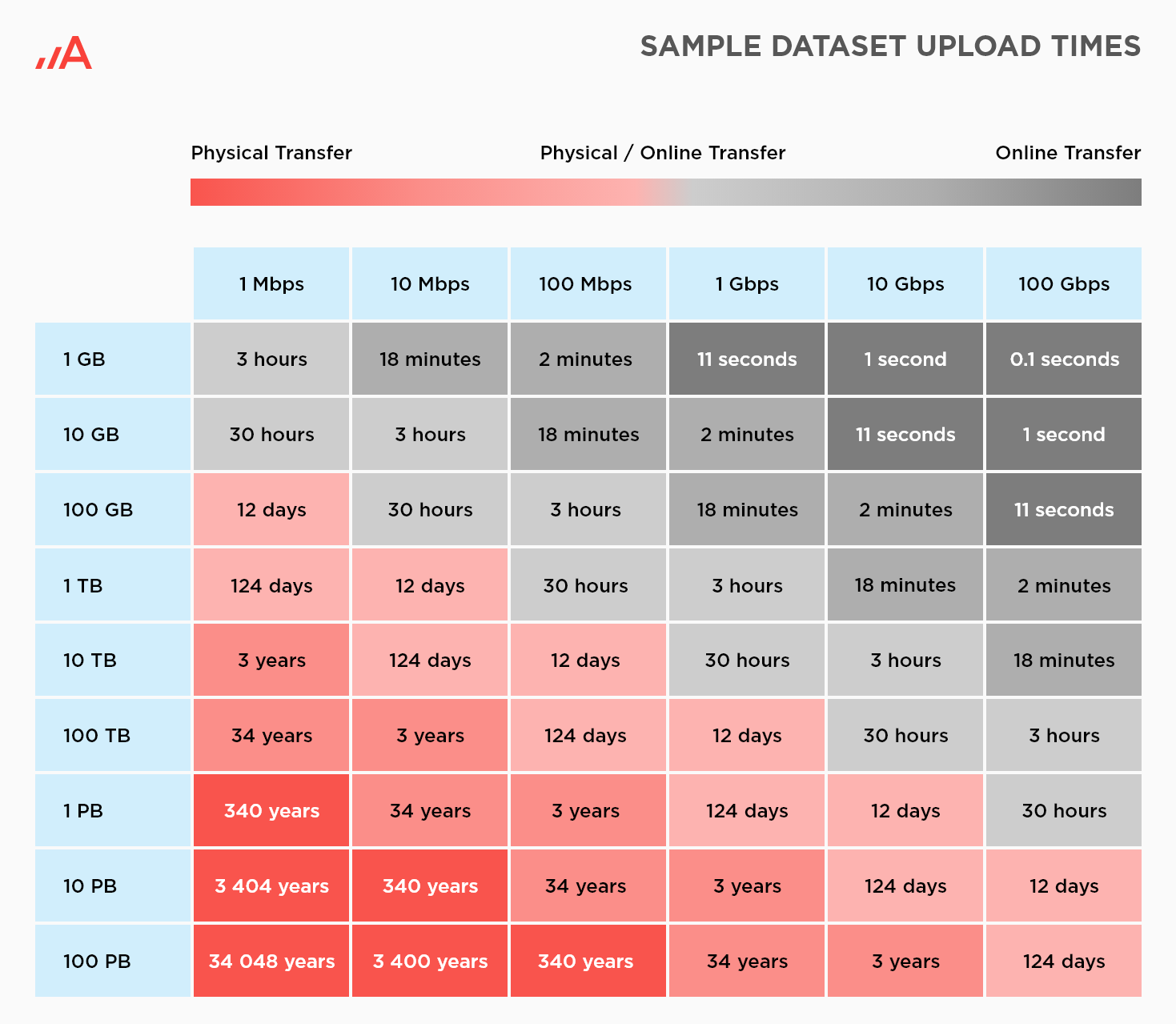
Illustration 1: Sample Dataset Upload Times
Is it worth it if that is a one-time operation for your data warehouse management application? My short answer is no. That is why Google Cloud provides a dedicated service for such a single act of data migration, called Transfer Appliance. It is a storage server that helps you set up your data center. You can upload and ship your data to Google Warehouse, which will further be migrated to Google Cloud Storage by their consultants. It could hold up to a petabyte of compressed data. It is safely encrypted at capture, and later decrypted when reaches the final Google Cloud destination.
Use Case
Offline transfer appliance is suited for migrating large amounts of existing data to Google Cloud Platform. It provides numerous of options for more-frequently used data and archival data in low-cost, highly durable, and highly available storage classes. You can migrate everything from audio data and satellite images to sensor data. A popular use case is migrating an HDFS cluster.
Advantages
- Quickly migrate petabytes of data without a need for unnecessary network improvement.
- Seamlessly migrate your Big Data on-premise Hadoop to Google Cloud Platform.
- Your data is securely encrypted at capture.
- You are the holder of the encryption keys that insure only you can decrypt your data.
On the same wave, another advantage is the cost. You avoid consuming any outbound network bandwidth and save decent amount of money while huge volumes of data are being migrated to Google Cloud.
Conclusion
To wrap it up, I’d like to share something I`ve learned the hard way.
“Any try to save some time, not expanding the team`s skillset, or avoid investment on the route to complete a cloud-native migration is just buying yourself more future technical debt.”
Every enterprise and workloads are different, but they have something in common – all are aiming to take advantage of the unique cloud features. This can be achieved only by embracing cloud-native design principles and refactoring the existing applications.
Please, do not get me wrong. You don’t need to Rip and Replace everything at once. There are enough gradual cloud migration strategies that can help you migrate your monolith applications over time. You need to have a good plan and time to upskill your team, rewrite your code, and eventually rely on a trustworthy technology partner who will always stay by your side in the Google Cloud migration journey.

